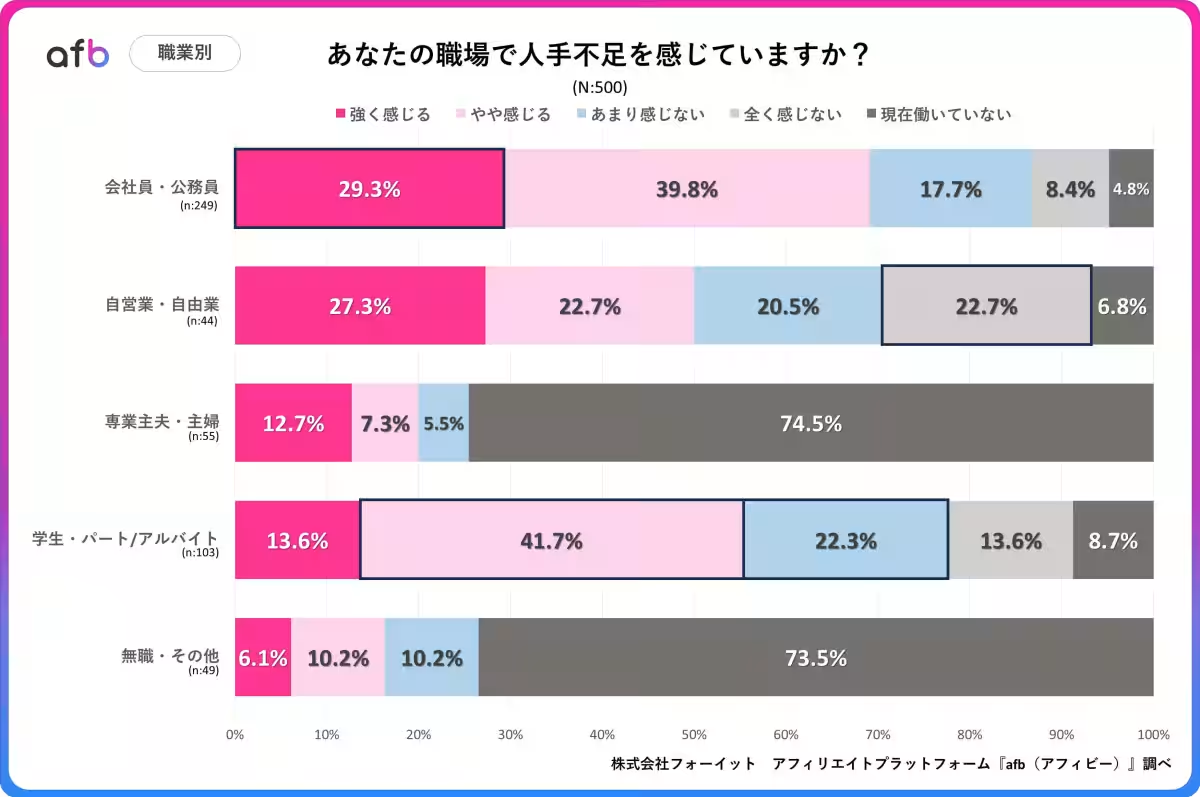

The Intensifying Labor Shortage: Insights from Nationwide Survey by For-it
The Intensifying Labor Shortage in Japan
In recent years, Japan has been grappling with a significant labor shortage, driven by factors such as the declining birth rate and aging population. A recent survey conducted by the affiliate platform For-it gathered insights from 500 individuals aged between 20 and 69 to understand the extent of this issue across various demographics.
With the labor force shrinking and job markets turning into applicants' fields, many companies are facing difficulties in hiring personnel. The survey aimed to determine how many employees feel the impact of labor shortages in their workplaces.
Respondents were asked: "Do you feel there is a labor shortage at your workplace?" The options were:
1. Strongly feel it
2. Slightly feel it
3. Do not feel it much
4. Do not feel it at all
5. Currently not employed
The results were quite revealing, with over 50% of respondents indicating that they feel a labor shortage:
This shows that a significant portion of the workforce is aware of the labor scarcity in various occupations and industries.
Interestingly, the perception of labor shortage varies by region. Those in Kyushu and Okinawa reported the highest feelings of labor shortages, with over 60% confirming either strong or slight feelings of scarcity. This may be attributed to population dynamics, particularly the outflow of younger individuals to more urban centers like Tokyo. The labor environment there is compounded by low wages and fewer job opportunities.
According to data from the Ministry of Health, Labour and Welfare, average wages in Kyushu and Okinawa are among the lowest in Japan, leading to retention issues for younger generations. For instance, the average salary in Miyazaki is only 2.598 million yen. This economic landscape contributes to a lack of available jobs, reinforcing the cycle of underemployment and regional poverty.
The survey results also highlighted differences in labor shortage perceptions among various professions. About 70% of company employees and public servants reported feeling either strong or slight labor shortages, while only about 50% of self-employed individuals felt similarly. This divergence is likely due to the flexibility in managing workloads that self-employed workers enjoy, allowing them to avoid the constraints often felt in corporate environments.
Moreover, the survey revealed that perceptions of labor shortages also correlate with household income levels. Respondents from households earning above 10.01 million yen reported over 70% experiencing labor shortages. This demographic is often composed of management-level individuals who bear the responsibility of overseeing various organizational progressions, making them particularly sensitive to staffing issues.
The data projects concerning trends suggest that the challenges associated with labor shortages will likely intensify if efforts towards addressing the core factors aren't undertaken. Businesses will need to adopt strategies like digitalization, AI integration, and enhancing work environments to tackle these growing issues. For job seekers, however, this could signal a shift towards a more favorable job market, where candidates can select from more options and better conditions.
For more information about the labor shortage in Japan, visit afb.
For-it operates the afb affiliate platform, which has been recognized for its high satisfaction rates among high-income partners for over a decade. With around 20 years of experience and more than 115,000 partners, they leverage extensive data to optimize advertising effectiveness and promote sustainable growth in the affiliate marketing landscape.
For potential partners, registration is available through the following links:
The insights from For-it serve as a reminder of the urgency of addressing labor market challenges across Japan as demographic shifts continue to evolve.






In recent years, Japan has been grappling with a significant labor shortage, driven by factors such as the declining birth rate and aging population. A recent survey conducted by the affiliate platform For-it gathered insights from 500 individuals aged between 20 and 69 to understand the extent of this issue across various demographics.
Background of the Survey
With the labor force shrinking and job markets turning into applicants' fields, many companies are facing difficulties in hiring personnel. The survey aimed to determine how many employees feel the impact of labor shortages in their workplaces.
Survey Methodology
- - Target demographic: Men and women aged 20-69
- - Sample size: 500 respondents
- - Geographic coverage: Nationwide
- - Survey method: Online
- - Date of survey: April 18, 2025
Key Question
Respondents were asked: "Do you feel there is a labor shortage at your workplace?" The options were:
1. Strongly feel it
2. Slightly feel it
3. Do not feel it much
4. Do not feel it at all
5. Currently not employed
Survey Findings
The results were quite revealing, with over 50% of respondents indicating that they feel a labor shortage:
- - 32.2% reported they "slightly feel it."
- - 21.8% strongly feel it.
- - 20.2% are currently not working.
This shows that a significant portion of the workforce is aware of the labor scarcity in various occupations and industries.
Regional Disparities in Labor Shortage Perceptions
Interestingly, the perception of labor shortage varies by region. Those in Kyushu and Okinawa reported the highest feelings of labor shortages, with over 60% confirming either strong or slight feelings of scarcity. This may be attributed to population dynamics, particularly the outflow of younger individuals to more urban centers like Tokyo. The labor environment there is compounded by low wages and fewer job opportunities.
According to data from the Ministry of Health, Labour and Welfare, average wages in Kyushu and Okinawa are among the lowest in Japan, leading to retention issues for younger generations. For instance, the average salary in Miyazaki is only 2.598 million yen. This economic landscape contributes to a lack of available jobs, reinforcing the cycle of underemployment and regional poverty.
Professional vs. Self-Employed Perspectives
The survey results also highlighted differences in labor shortage perceptions among various professions. About 70% of company employees and public servants reported feeling either strong or slight labor shortages, while only about 50% of self-employed individuals felt similarly. This divergence is likely due to the flexibility in managing workloads that self-employed workers enjoy, allowing them to avoid the constraints often felt in corporate environments.
Influencing Factors Related to Income
Moreover, the survey revealed that perceptions of labor shortages also correlate with household income levels. Respondents from households earning above 10.01 million yen reported over 70% experiencing labor shortages. This demographic is often composed of management-level individuals who bear the responsibility of overseeing various organizational progressions, making them particularly sensitive to staffing issues.
Looking Ahead
The data projects concerning trends suggest that the challenges associated with labor shortages will likely intensify if efforts towards addressing the core factors aren't undertaken. Businesses will need to adopt strategies like digitalization, AI integration, and enhancing work environments to tackle these growing issues. For job seekers, however, this could signal a shift towards a more favorable job market, where candidates can select from more options and better conditions.
For more information about the labor shortage in Japan, visit afb.
About For-it
For-it operates the afb affiliate platform, which has been recognized for its high satisfaction rates among high-income partners for over a decade. With around 20 years of experience and more than 115,000 partners, they leverage extensive data to optimize advertising effectiveness and promote sustainable growth in the affiliate marketing landscape.
For potential partners, registration is available through the following links:
- - New Affiliate Partners: Sign up here
- - Influencer Registration via Social Media: Register here
- - New Advertisers: Register here
The insights from For-it serve as a reminder of the urgency of addressing labor market challenges across Japan as demographic shifts continue to evolve.






Topics Business Technology)










【About Using Articles】
You can freely use the title and article content by linking to the page where the article is posted.
※ Images cannot be used.
【About Links】
Links are free to use.